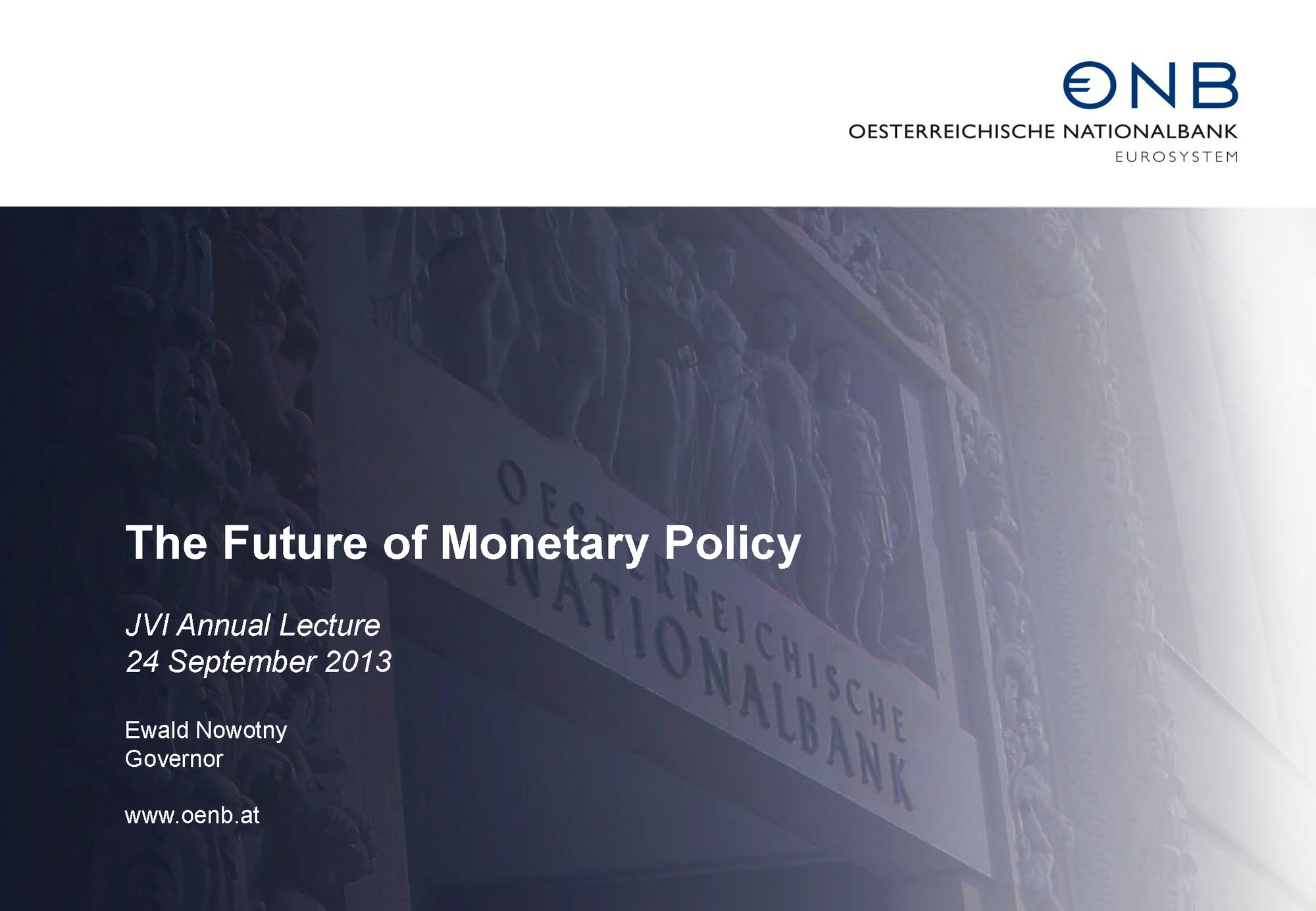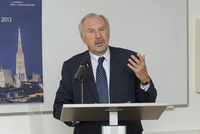Tuesday, September 24
Presenter
Ewald Nowotny, Governor, Oesterreichische Nationalbank
Summary
Prof. Ewald Nowotny, the Governor of the Oesterreichische Nationalbank, delivered this year’s JVI Annual Lecture on September 24, 2013. Gov. Nowotny spoke about the key challenges that monetary policy is facing in the wake of the financial crisis of 2008, and how these will affect the conduct of monetary policy in the future. “Monetary policy … faces a double challenge,” the Governor emphasized. “In the short run, stability has to be restored while in the long term an enduring framework has to be established that is capable of preventing the recurrence of a crisis as the one seen in 2008.” The major central banks, Gov. Nowotny explained, cannot expand their balance sheets forever, so sooner or later they will have to exit from their current policies. Determining the right timing and strategy for the exit policies, as well as clearly communicating them to the public, remain the biggest challenges for the monetary authorities in the medium term. At the same time, recent policy innovations, such as the tighter coordination between prudential policies and monetary policies, as well as increased international cooperation, will likely remain part of the monetary policy framework in the future, Gov. Nowotny said.
Governor Nowotny outlined the new challenges that the 2008 financial crisis presented for central bankers all around the world. Before the crisis, a consensus had emerged that monetary policy should be delegated to an independent agency with the single objective of price stability. Fiscal, prudential, and monetary policies were thought to operate separately, and hence required a minimum of coordination. While the consensus worked fine for some time in the U.S. and Europe—resulting in stable output growth combined with low inflation—the events in 2008 disproved it. Prudential policy had not been able to prevent the financial crisis. “A key lesson of the crisis,” the Governor noted, “was … that in the absence of financial stability, monetary policy can be severely hampered and fiscal policy pushed off track.”
Using the Central Banks’ Balance Sheets
To re-establish financial stability and growth, the central banks in the U.S. and Europe switched from interest rate policies, which were no longer potent, to balance sheet policies, Gov. Nowtony explained. The U.S. Federal Reserve first expanded its balance sheet through new lending programs for troubled banks. Subsequently, it bought mortgage-backed securities and longer-term US Treasury securities to reduce long-term interest rates. The ECB expanded its balance sheet mainly through regular refinancing operations that provided liquidity to banks against collateral. The Swiss National Bank’s (SNB) foreign exchange market interventions to hold back the appreciation of the Swiss franc boosted its balance sheet considerably. As a result of these unconventional monetary policies, the Governor indicated that the Fed’s balance sheet grew four-fold between 2007 and 2013, the ECB’s balance sheet had more than doubled at its peak in 2012, and the balance sheet of the SNB increased five-fold.
The balance sheet policy of the central banks was complemented by forward guidance, Prof. Nowotny noted. Central banks had begun to explicitly communicate their future policy intentions to the public—both regarding balance sheet operations and interest rates—in order to anchor market expectations and reduce uncertainty about the future course of monetary policy.
Eventual Exit from Unconventional Policies
In the medium term, the central banks will eventually have to phase out the unconventional measures. This poses several formidable challenges for policymakers, Gov. Nowotny stressed. First, they must find the appropriate timing and sequence of exit policies. According to the Governor, “…exiting too early or too fast may create risks to economic growth and employment … exiting too late or too slowly may create risks to price stability, both over the short and the medium term, and distort the private sector’s incentives to continue balance sheet repair.” At the same time, exit strategies will need to respond flexibly to changing economic conditions and should involve gradual and steady rather than occasional and disruptive action.
The second key challenge is to carefully communicate the exit strategy to the public. The Governor explained that striking the right balance between clarity and transparency of the forward guidance can prove especially difficult, given that the exit process will unlikely be short and will need to be altered along the way as economic conditions change. “We need to choose forward guidance practices carefully from the start, so that sizeable revisions do not become necessary later,” he emphasized.
The third challenge, Gov. Nowotny explained, was that monetary authorities must take into account the potential international liquidity spillovers from their policies. Continuing the accommodative stance of the monetary policy for too long may contribute to the build-up of systemic risks. Exiting too early and too sharply may, however, cause sudden reversals of the capital flows and disruptions in emerging markets.
A New Monetary Policy Framework
In the long term, it is unlikely that monetary policy will return to its pre-crisis framework, the Governor noted. Considering the tight links between financial stability and macroeconomic stability, one policy innovation that was likely to survive is the coordination of prudential policy and monetary policy. The new Single Supervisory Mechanism within the ECB is a step in that direction. At the same time, Gov. Nowotny cautioned that taking over the supervisory role may expose central banks to additional reputational risks. “In my view,” the Governor said, “no central banker with an adequate survival instinct will seek actively a larger role in banking supervision.”
Another innovation that will probably remain part of the future monetary policy framework is closer international cooperation. International arrangements, such as swap lines between central banks, can prevent shortages of foreign currency liquidity and can thus reduce the precautionary incentives to hold costly foreign exchange reserves, the Governor noted.
Questions from the Audience
The lecture was followed by a lively discussion. For example, one questioner noted that recent messages from the Fed about potential monetary tightening caused massive capital outflows from the emerging markets. Didn’t that suggest that the international cooperation was not working? Gov. Nowotny responded that even if the guidance of monetary policy were extremely cautious, international spillovers are still unavoidable. The Governor stressed that emerging markets have to manage international capital flows and need to be aware of possible reversals, especially if these capital flows are short-term. Another questioner asked whether the ECB is ready to prevent deflation should that become necessary. Price stability, defined as keeping inflation below, but close to, two percent, remains the mandate of the ECB, Prof. Nowotny responded. If needed, he emphasized, ECB is ready to act against deflation—in general a harder task than dealing with inflation. The Governor noted, however, that as of now “… at the ECB, we are not in this territory” [of deflation].
Maksym Ivanyna, JVI Economist
Click here for the full text of the Governor’s speech.















